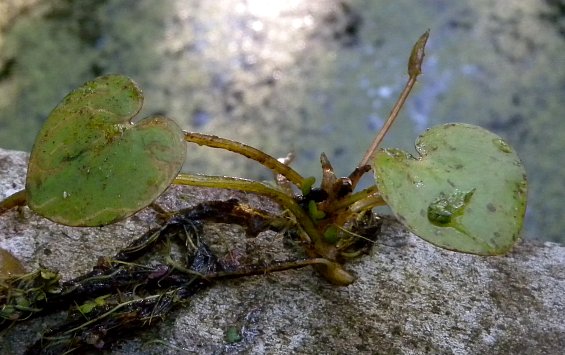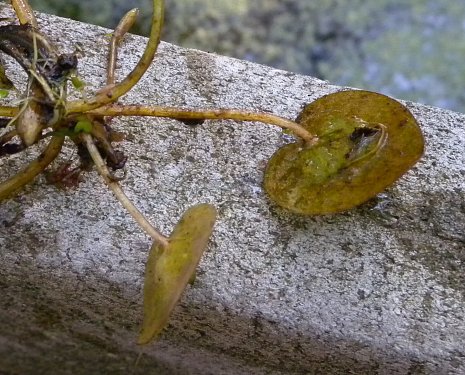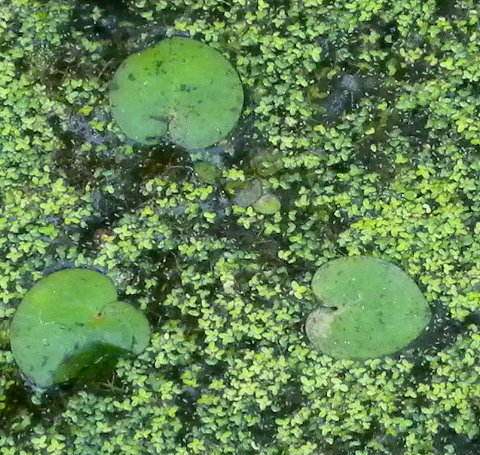
The blooming period occurs from mid-summer to early fall. Cross-pollination of the flowers probably occurs by either wind or water. Afterwards, pistillate flowers are replaced by globoid fruits; the pedicels of developing fruits bend downward into the water. These fruits are about ¼-½" (0.5-1.2 cm.) across at maturity; each fruit contains many spiny seeds that are released in a gelatinous mass. They are distributed at least in part by water. The root system is fibrous and stoloniferous; fibrous roots are branched, while the stolons float along the water surface. Clonal plants are produced periodically from the tips of the stolons. In the northern part of its range (including southern Illinois), the Sponge Plant (Limnobium spongia) overwinters as dormant turions (starchy winter buds) that sink below the surface of the water, while in warmer climates it can grow throughout the year.
Cultivation: The preference is full or partial sun and wet conditions. The Sponge Plant (Limnobium spongia) can float on water or root itself in mud; it does not like to dry out. The water should be stagnant or very slow-moving. The Sponge Plant can spread aggressively in warm climates by means of its stolons; this is less of a problem in climates with winter temperatures that are substantially below-freezing. This plant can be cultivated indoors in either an aquarium or wet terrarium. A fungal disease, Cercospora limnobii, can cause brown lesions to develop on the leaf blades.

Range & Habitat: The native Sponge Plant (Limnobium spongia) is restricted to southern Illinois, where it is rare (see Distribution Map). Illinois lies along the northern range limit of this species. It is more common in areas further to the south and southeast. Habitats include swamps, the water of lakes and ponds, muddy borders of lakes and ponds, and deep ditches. In southern Illinois, the Sponge Plant can be found in Bald Cypress swamps. It can be found in both high quality and disturbed wetlands (usually the former in Illinois).
Faunal Associations: Information about floral-faunal relationships for this species is relatively limited. The somewhat succulent leaves of Sponge Plant (Limnobium spongia) are eaten by the Slider (Trachemys scripta) and other turtles (Ernst et al., 1994), while its fruits and seeds are eaten by such waterfowl as the Golden Eye, Green-Winged Teal, Mallard, Old Squaw, Northern Pintail, Ring-Necked Duck, and Wood Duck (Les & Mehrhoff, 1999; observed in southern New England). The gelatinous spiny seeds can stick to the feathers or feet of waterfowl and conveyed from one wetland to another, thereby distributing the seeds to new locations. Similarly, watercraft may spread the seeds to new wetland locations using the same method.

Photographic Location: A Bald Cypress swamp in southern Illinois.
Comments: The Sponge Plant (Limnobium spongia) can be distinguished from many other wetland plants by its heart-shaped leaves. An exception is the European species, Frog's Bit (Hydrocharis morsus-ranae), which has leaves of similar shape and size. This latter species also adapts to wetland habitats by floating on water or becoming stranded on mud. As a result, these two species are sometimes confused, especially by some commercial nurseries that advertise the European Frog's Bit as the Sponge Plant (or American Frog's Bit). Unlike the Sponge Plant, however, the floating leaves of Frog's Bit lack spongy swellings on their undersides. In addition, the flowers of Frog's Bit are quite distinct in appearance from those of Sponge Plant, because the former have showy white petals that are longer than their sepals.